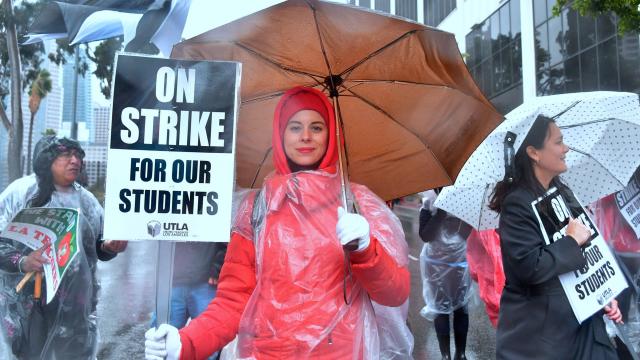
Yevgeniya Pokhilko, an elementary school teacher, holds a sign. Photograph: Frederic J Brown/AFP/Getty Images
Thousands of teachers decked in red and black braved torrential rain in downtown Los Angeles on Monday, carrying giant umbrellas and signs about class sizes as they demanded more resources for their students – and a halt to what they see as the encroaching privatization of their profession. It was the first day of a strike that has largely halted education in the United States’ second-largest school district.
“We’re here because we want to stand up for our students,” Maria Ortiz, a teacher at Evergreen elementary school, said amid a downpour, ducking for cover at a bus stop.
“It’s not about pay. We want smaller class sizes. A fully funded nurse. Psychologists,” she said. While money goes toward an increasing number of charter schools, many public school teachers feel it is at their expense. “We seem to be fighting for things that are basic in education,” Ortiz said, “and that is a sad situation, all around.”
The Los Angeles unified school district serves more than 640,000 students – more than twice the number enrolled in West Virginia, where teachers went on strike a year ago over wages they said were not enough to cover the rising cost of life.
In LA the district has already offered a 6% increase in salary. But that proposed raise, teachers say, is not the only goal that made them call the first strike since 1989.
“People like to say we’re out here for the money,” said Stephen Altamirano, a teacher at Corona elementary school. “But in reality, if we wanted the money we already got that,” he said. “We’re here because we’re trying to get what’s best for our kids.”
United Teachers Los Angeles, the union representing the district’s 30,000 teachers, describes the school district’s last offer as “insulting”. Salary increases are tied to healthcare cuts, it notes, and class sizes could be capped as high as 39 at elementary schools and 46 thereafter – if not higher in practice.
Teachers, who overwhelmingly voted to strike last August, want the school district to spend some of its $1.8bn surplus to reduce those class sizes, to subject students and teachers to fewer standardized tests, and to check the growth of charter schools.
“We have not come this far to settle for so little,” the UTLA president, Alex Caputo-Pearl said in a statement.
The school district maintains that is not just sitting on that surplus but spending it on other priorities, including an additional 1,200 educators, while reducing math and English sizes to 39 or fewer students. The district said it was “extremely disappointed” that teachers had rejected this offer, it said in a statement.
But NM Windman, a special education teacher at Lincoln high school, reiterated what every teacher said: that it was not about them. “This is mostly to let people know it’s unacceptable what’s happening in public education,” he said, “and unfortunately it’s happening all across the country.”
There are “close to 40 students in most classes, which is unteachable”, Windman said. “These students have exceptional needs, and we just can’t meeting them. And it’s just progressing, getting worse and worse. Unfortunately, our district is allowing that to take place.”
On the streets, at least, strikers had the support of honking drivers and the parents of those they teach, and a man selling bacon-wrapped hot dogs said he was offering them a dollar off.
Stacey McKenna, the mother of a child at Mulholland middle school, said she supports the strike, even though it means her daughter will miss a few lessons. “They are not asking for anything unreasonable,” she said. “Smaller class sizes, more support staff like librarians, counselors, nurses – staff we used to have at school all day, every day, and now get maybe one or two days a week if we’re lucky.”
She hopes the school district learns a lesson itself.
“Profit isn’t everything,” she said. “There are more important things out there, like educating our kids.”
Originally published by The Guardian














